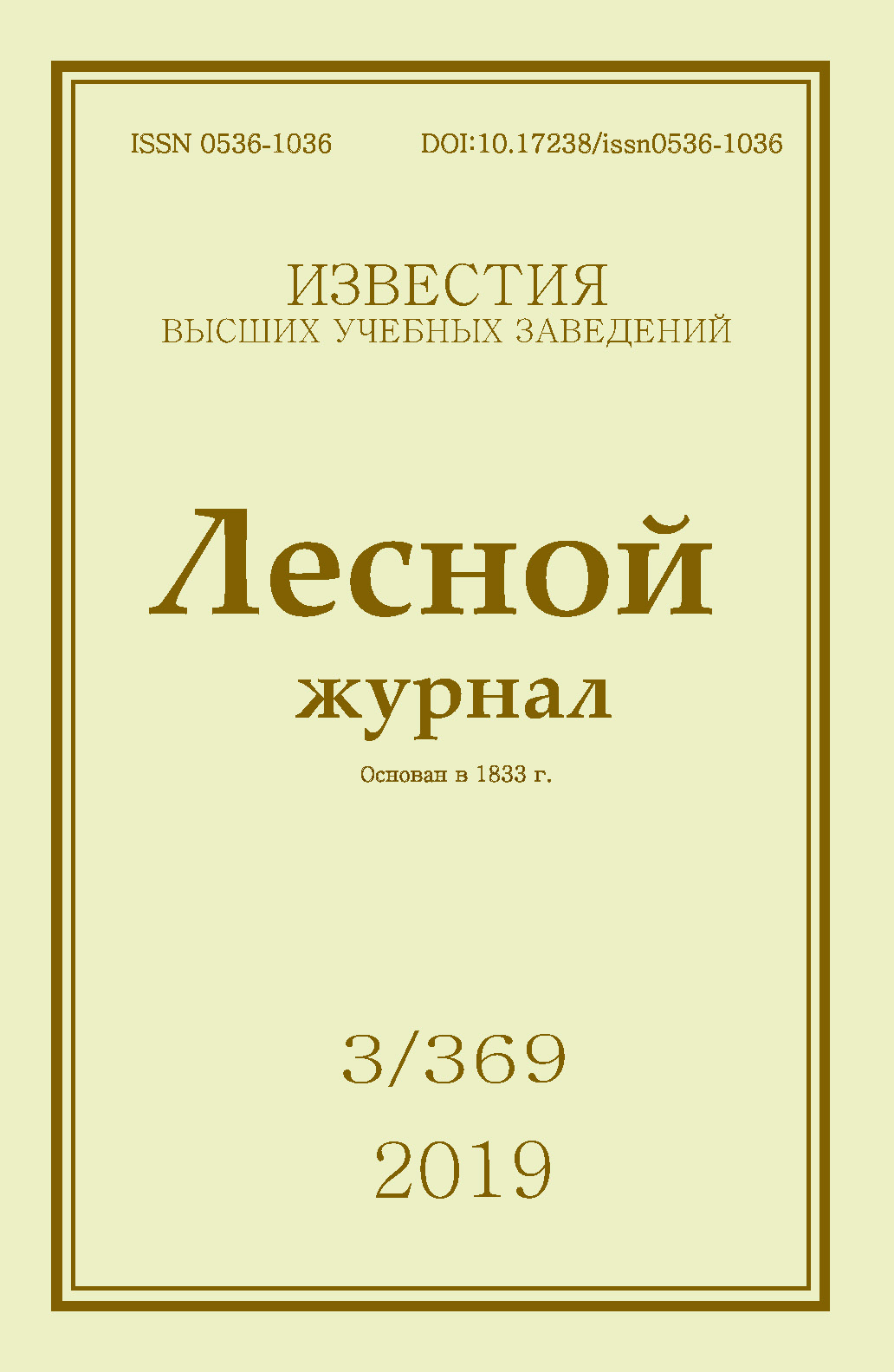Chemical Composition of Phenolic Fraction of Wood Ablative Pyrolysis Resin
DOI:
https://doi.org/10.17238/issn0536-1036.2019.3.132Keywords:
ablative pyrolysis, birch wood, phenolic fraction, NMR spectroscopy, IR spectroscopy, gas chromatography-mass spectrometryAbstract
The results of chemical analysis of resin phenolic fraction of ablative pyrolysis birch wood are presented. The phenolic fraction was isolated by extraction with 10 % aqueous sodium hydroxide solution. The total yield of the phenolic fraction of ablative pyrolysis resin was 5.3 % per total condensate. The isolated alkaline extract was studied by 1H and 13C nuclear magnetic resonance (NMR) spectroscopy, infrared (IR) spectroscopy, and gas chromatography-mass spectrometry (GC–MS). The data of 1H NMR spectroscopy were used for quantitative analysis of inputs of definite groups of protons to the total spectrum. Therefore, 1Н NMR spectrum was divided into seven regions, which corresponds to the following types of protons: aromatic (δ = 6.5–9.0); phenolic OH (δ = 5.0–6.5); Ar–CH2–Ar (δ = 3.3–4.5); α-CH3, СН2, and СН (δ = 2.0–3.3); β-СН2 and СН (δ = 1.6–2.0); β-CH3, СН2, and γ-СН (δ = 1.0–1.6); γ-CH3 (δ = 0.5–1.0). Proton integral intensity was determined and its input on a proton intensities sum of all distinguished regions of 1H NMR-spectra were calculated for each region. It has been found that phenolic fraction of ablation pyrolysis resin contains more aliphatic groups in comparison with phenolic fraction of conventional pyrolysis resin, while resin extract contains more aromatic groups. The GC–MS data had shown that the following phenols make the greatest contribution to the formation of ablation pyrolysis resin: 1,2-dihydroxybenzene, 4-methyl-2,6-dimethoxyphenol and 2,6-dimethoxyphenol. Insignificant formation of guaiacol is explained by deciduous wood taken for pyrolysis. IR spectroscopy had shown that pyrolysis resins contain phenolic, alcohol, and carbonyl functional groups and aromatic compounds. The fraction isolated by alkaline extraction contains a significant amount of phenols, which allows its modification for the purposes of obtaining marketable products.
For citation: Mikulintseva M.Yu., Ponomarev D.A., Grachev A.N., Pokryshkin S.A., Kosyakov D.S. Chemical Composition of Phenolic Fraction of Wood Ablative Pyrolysis Resin. Lesnoy Zhurnal [Forestry Journal], 2019, no. 3, pp. 132–142. DOI: 10.17238/issn0536-1036.2019.3.132
The research was carried out using the equipment of the Shared Use Equipment Center “Arktika” of the Northern (Arctic) Federal University named after M.V. Lomonosov.
Downloads
References
Грачев А.Н. Разработка методов расчета технологии и оборудования пирогенетической переработки древесины в жидкие продукты: автореф. дис. ... д-ра техн. наук. Казань, 2012. 36 с.
Грачев А.Н., Сафин Р.Г., Хисматов Р.Г., Макаров А.А. Экспериментальные исследования скорости убыли массы древесины в процессе быстрого абляционного пиролиза // Лесн. журн. 2009. № 4. С. 116–122. (Изв. высш. учеб. заведений).
Зорин Б.Я., Демченко Е.А., Тришин В.М., Киприанов А.И. Исследование химического состава фенольной фракции коптильного препарата методом хромато-масс-спектрометрии // Лесн. журн. 2003. № 2-3. С. 107–111. (Изв. высш. учеб. заведений).
Киповский А.Я., Пиялкин В.Н., Белоусов И.И., Прокопьев С.А. Роль температурно-временных факторов при ультрапиролизе древесного сырья // Лесн. журн. 2004. № 4. С. 85–92. (Изв. высш. учеб. заведений).
Марьяндышев П.А., Чернов А.А., Любов В.К. Анализ термогравиметрических и кинетических данных различных видов древесного биотоплива Северо-Западного региона Российской Федерации // Лесн. журн. 2016. № 1. С. 167–182. (Изв. высш. учеб. заведений). DOI: 10.17238/issn0536-1036.2016.1.167
Cумароков В.П., Володуцкая З.М., Высотская В.А., Клинских Е.В. Методы анализа продуктов пирогенетической переработки древесины. М.; Л.: Гослесбумиздат, 1960. 252 с.
Уваров И.П., Гордон Л.В. Древесные смолы (синтетические продукты на основе лесохимических фенолов). М.: Гослесбумиздат, 1962. 84 с.
Ben H., Ragauskas A. In Situ NMR Characterization of Pyrolysis Oil during Accelerated Aging // ChemSusChem. 2012. Vol. 5, iss. 9. Pp. 1687–1693. DOI: 10.1002/cssc.201200429
Biomass to Biofuels: Strategies for Global Industries / ed. by A.A. Vertes, N. Qureshi, H. Yukawa, H.P. Blaschek. Chichester: Wiley, 2010. 584 p.
Garcia-Perez M., Adams T.T., Goodrum J.W., Geller D.P., Das K.C. Production and Fuel Properties of Pine Chip Bio-oil/Biodisel Blends // Energy & Fuels. 2007. Vol. 21(4). Pp. 2363–2372. DOI: 10.1021/ef060533e
Mohan D., Pittman C.U., Steele P.H. Pyrolisis of Wood/Biomass for Bio-oil: A Critical Review // Energy & Fuels. 2006, Vol. 20(3). Pp. 848–889. DOI: 10.1021/ef0502397
NIST Standard Reference Database Number 69 // NIST Chem Webbook. U.S. Secretary of Commerce, 2018. Режим доступа: https://webbook.nist.gov/chemistry/ (дата обращения: 06.12.19). DOI: 10.18434/T4D303







